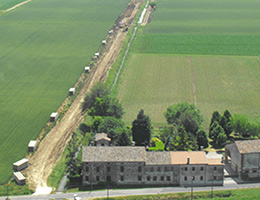Safety and corporate culture
The gas that Snam transports every day meets the energy needs of businesses and households. This means that customers and consumers place great emphasis on the value of accessible prices and a high-quality, uninterrupted service.
This also has to be the primary goal of any entity responsible for developing and managing network infrastructure. However, Snam is well aware of another value that is also a priority for everybody: being able to use gas wherever necessary, at home and in business, with the guarantee of safety for both people and property.
Snam has therefore always put safety first, making it the linchpin of its corporate culture and rooting it primarily in people, encouraging the growth of technical and operational knowledge so that gas represents a safe and reliable energy source for everyone.
Against this background, service security, continuity and quality are intrinsically linked and represent a shared value.
Infrastructure safety
During a normal year, plants and pipes periodically undergo inspections and maintenance operations.
In the transportation segment, for example, the course of the pipelines is inspected regularly on foot, by land vehicles and by helicopter fly-overs to detect potentially dangerous situations caused, for example, by third-party work near the pipelines. Similarly, any land slippage at specific points of the route is also kept under surveillance. The integrity of the pipes is also monitored by inserting intelligent devices inside them to identify any defects (so-called intelligent pigs).
| Download XLS (22 kB) |
|
OVERSIGHT AND INSPECTION OF TRANSPORTATION ACTIVITY |
|||
|
|
|
|
|
|
|
2012 |
2013 |
2014 |
|
Network inspected using intelligent pigs (km) |
2,098 |
2,342 |
1,950 |
|
Network inspected with helicopter fly-overs (km) |
>15,000 |
15,400 |
15,700 |
The 11 gas compression stations situated along the 32,000 km of pipeline network are controlled directly by the recently renovated dispatching unit at San Donato Milanese, which is responsible for ensuring that pressure levels are sufficient to meet demand.
The dispatching unit is a strategic infrastructure that manages gas flows in the national transportation network: its 24/7 operations room monitors and remotely controls the main pipelines and the compression stations of the Italian gas system. A 46-m2 video wall gives operators an overview of the national gas transportation network, showing the major points of interest and related information.
The dispatching unit regulates and controls the national gas transportation system to ensure that it functions safely, reliably and efficiently, and it also oversees balancing on the basis of actual gas demand, which can fluctuate significantly on a daily and seasonal basis.
In distribution, Snam regularly undertakes inspections and maintenance operations at its gas reduction plants, and continually checks the condition of the steel pipes: in 2014, approximately 8,190 significant points on the network were monitored, and over 30,000 specific measurements were taken. More than 22,000 km of network were inspected.
Infrastructure safety: drill programmes
Within the infrastructure safety framework, Snam and the operating companies that it controls pursue their own improvement targets, including by taking part in institutional drill programmes.
In 2014, the main national and international activities in which Snam participated concerned tsunami and volcano risks (Directive of 14 February 2014 of the Department of Civil Protection). These involve information exchange and the sharing of methods and practices, with the institutions overseeing infrastructure safety and the companies providing essential services for the country. In this context, Snam collaborates with the Italian Department of Civil Protection, with the aim of strengthening the management model for emergency response in procedural, organisational, training and operational terms.
In the procedural and organisational domain, Snam has adopted the measures established at the national level for managing activities in the event of a volcanic eruption with a strong emphasis on activities aimed at restoring infrastructure and the networks needed to continue economic and production activities and to resume normal living conditions in the country.
From September to December 2014, Snam participated in the preparation, execution and analysis of the NEAMWAVE 14 drill that was organised at the European level by the Department of Civil Protection. The goal of the NEAMWAVE programme is to initiate a sharing strategy at the national level on the issue of tsunamis by supplementing essential services in the Civil Protection’s warning system.
Preventative checks on the reliability of the distribution system by seeking atmospheric gas dispersions is an important source of information used to decide what action to take.
To make the otherwise odourless and colourless gas detectable when it is dispersed, Snam uses odorisation plants equipped with innovative automated injection systems, which measure out quantities of odoriser according to the volumes of gas distributed.

Helicopter fly-overs are a shared value with the region
In 2014 a protocol was signed to start collaborating with the “Lelio Pagani” Regional Research Centre at the University of Bergamo. The collaboration involves giving the University, free of charge, the aerial photographs taken during fly-overs to monitor the network. These may serve as a point of reference for a number of studies and research projects aimed at gaining a more detailed knowledge of the many aspects of the region (agriculture, forests, geology, town planning, landscape, etc.). In fact, the work of the Research Centre is mainly carried out on the basis of analyses of geographical representations based on zenith views and blueprints. The “bird’s eye view” produced by Snam during fly-overs to monitor the network is rarely used in cartographic representations, but is particularly attractive and can be immediately interpreted. Thus, this information will be used and exploited for various educational, cultural and analytical purposes, and in this context, the creation and updating of a catalogue of aerial photographs over time may serve as an important tool for learning about the region concerned, and therefore contribute to the reconstruction of historical transformations over a specific period of time.